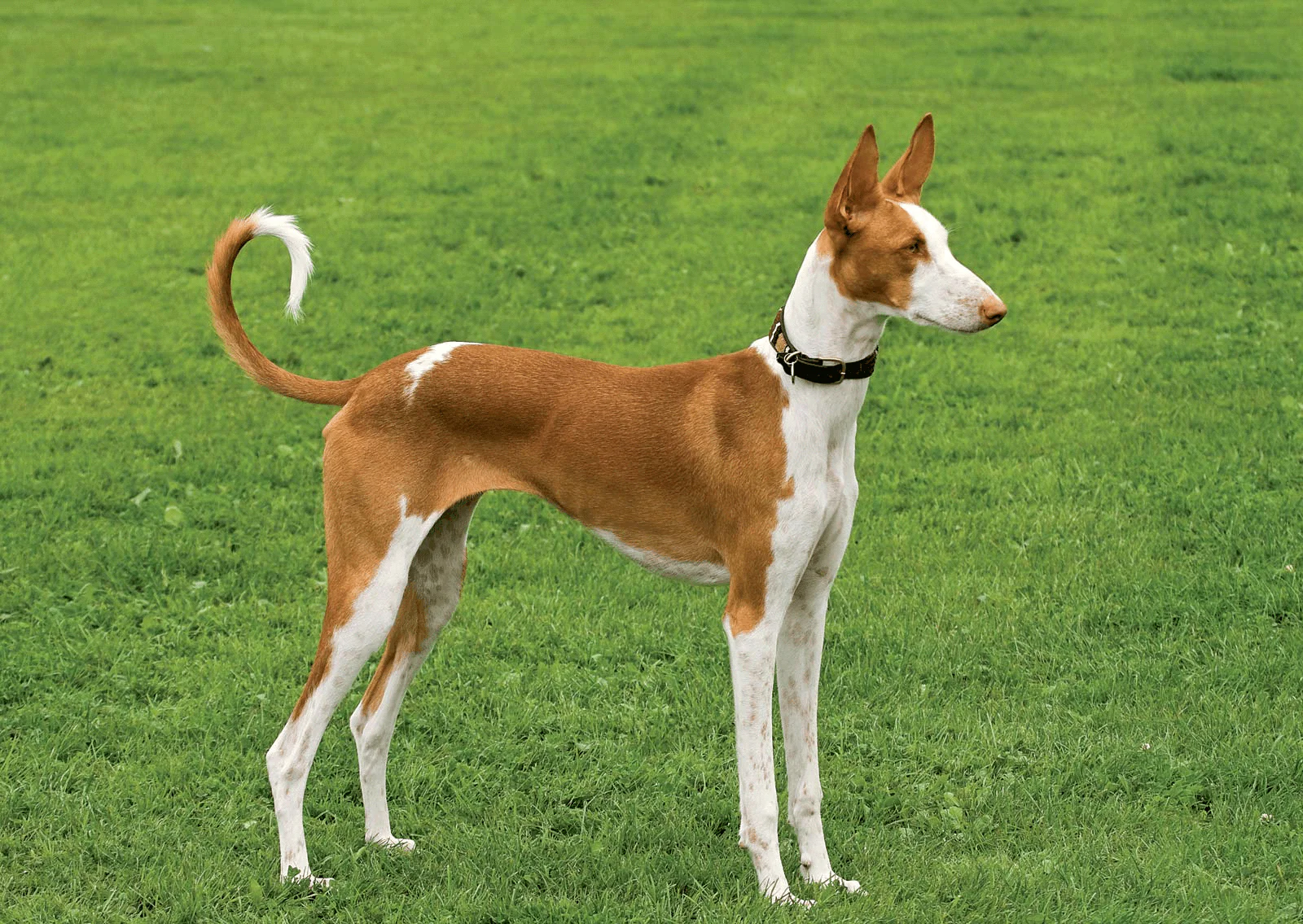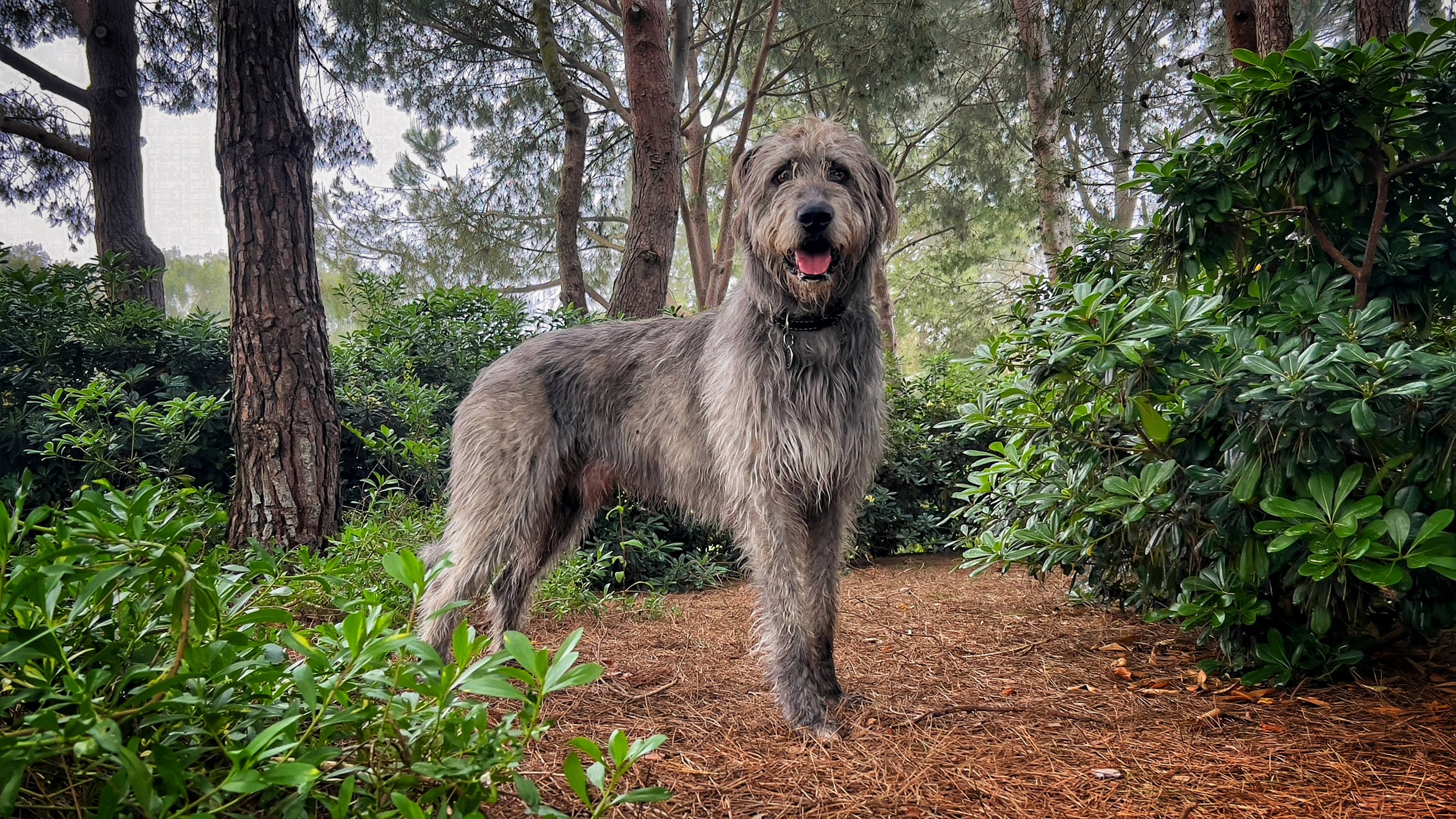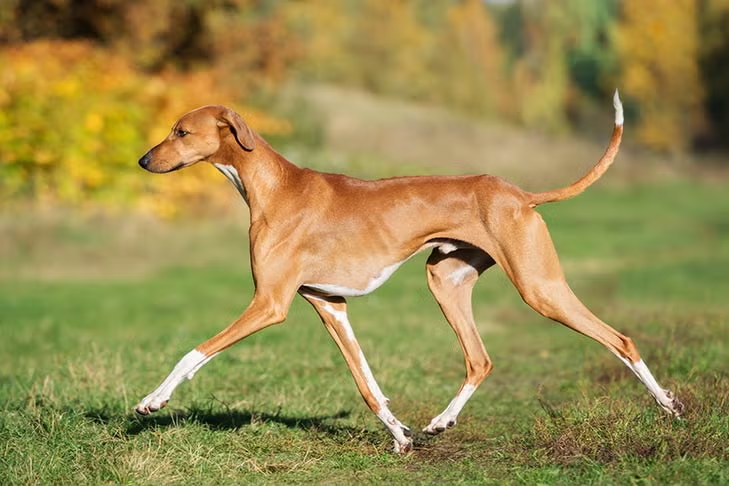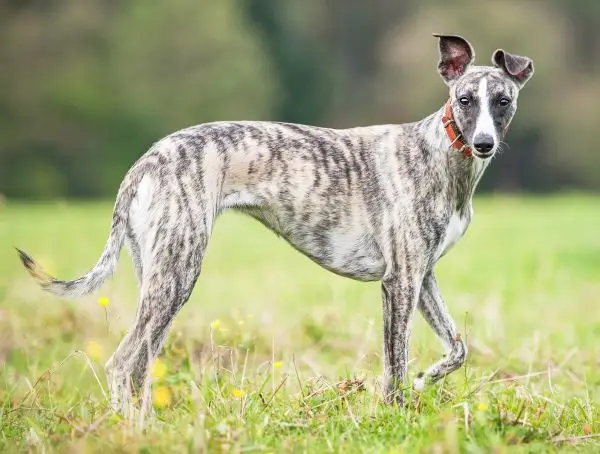My First Enchanting Encounter with an Ibizan Hound
The first time I saw an Ibizan Hound in person was at a dog show in Santa Barbara. I remember stopping dead in my tracks, completely mesmerized by what appeared to be a living piece of ancient Egyptian art. With its elegant, elongated silhouette, enormous upright ears, and graceful movement, this dog seemed to float rather than walk. As I stood there staring, the owner noticed my fascination and beckoned me over. “This is Anubis,” she said with a smile, “and yes, he knows he looks like an Egyptian god.”
As I spent time with Anubis, I was struck by how this regal-looking creature could switch from dignified statue to playful goofball in seconds. One moment he was standing majestically, radar ears swiveling to catch every sound; the next, he was prancing around with a silly toy, making his owner laugh. “They’re ancient, but they never really grow up,” she explained. “He’s eight years old and still acts like a puppy half the time.” That fascinating contradiction—a dog with an ancient lineage and dignified appearance but a perpetually youthful spirit—completely captivated me.
If you’ve never had the pleasure of meeting an Ibizan Hound (or “Beezer” as enthusiasts affectionately call them), you’re missing out on one of the most distinctive and enchanting breeds in the dog world. With their striking appearance, fascinating history dating back to ancient Egypt, and unique personality that combines independence with deep devotion, these dogs are truly special—even if they remain relatively rare outside their native Balearic Islands.
Whether you’re considering adding one of these elegant hounds to your family, fascinated by their incredible history, or simply curious about distinctive dog breeds, I’ve put together the ultimate guide to Ibizan Hounds. From their 5,000+ year history to what they’re actually like as companions (spoiler alert: they’re amazing but not for everyone!), we’ll cover everything you need to know about these remarkable dogs. So grab your favorite beverage, get comfortable, and let’s explore the wonderful world of Ibizan Hounds!
Ancient Mediterranean Heritage: The 5,000-Year History of Ibizan Hounds
To truly understand what makes Ibizan Hounds so special, we need to appreciate their extraordinary history, which stretches back thousands of years and has shaped every aspect of these remarkable animals.
Origins in Ancient Egypt and the Mediterranean
The Ibizan Hound’s history begins in ancient Egypt, where dogs remarkably similar to today’s breed appear in tomb paintings and artifacts dating back to around 3400 BCE. These elegant hunting dogs were highly valued in Egyptian society, often depicted alongside pharaohs and nobles in ancient art.
Phoenician traders are credited with bringing these dogs from Egypt to the Spanish island of Ibiza (part of the Balearic Islands in the Mediterranean) around the 8th or 9th century BCE. The island’s relative isolation allowed the breed to develop with minimal outside influence for nearly 3,000 years, preserving much of their ancient appearance and hunting abilities.
On Ibiza, these dogs (known locally as “Ca Eivissenc” in Catalan or “Podenco Ibicenco” in Spanish) were primarily used for hunting rabbits on the rocky, scrubby terrain of the island. Their remarkable jumping ability, keen eyesight, and acute hearing made them perfect for this purpose, as they could detect and pursue rabbits through the dense Mediterranean underbrush.
Traditional Hunting Methods
The traditional hunting method employed with Ibizan Hounds on the Balearic Islands is distinctive and showcases the breed’s natural abilities. Unlike many hunting dogs that work closely with humans, Ibizans were developed to hunt somewhat independently, using their exceptional senses to locate prey and their impressive athletic abilities to catch it.
Typically working in small packs, Ibizan Hounds would spread out to cover ground efficiently. When one dog detected a rabbit, it would signal to the others with body language and sometimes vocalizations. The pack would then coordinate their efforts, with some dogs flushing the rabbit from cover while others positioned themselves to intercept it.
Perhaps the most remarkable aspect of their hunting style is the spectacular leaping ability that has become a hallmark of the breed. Ibizans can spring straight up from a standstill to heights of 5-6 feet or more to spot prey or clear obstacles. This jumping prowess, combined with their agility and speed (they can reach speeds of up to 40 mph in short bursts), made them extraordinarily effective hunters in their native environment.
Journey to Modern Recognition
Despite their ancient lineage, Ibizan Hounds remained largely unknown outside the Balearic Islands until the early 20th century. The breed was first introduced to the United States in the 1950s by Colonel and Mrs. Consuelo Seoane, who imported several dogs from Spain.
The American Kennel Club recognized the Ibizan Hound in 1979, placing it in the Hound Group. However, the breed remains relatively rare in North America, typically ranking around 150th in popularity among AKC-registered breeds. This rarity has actually helped preserve the breed’s distinctive traits and natural abilities, as they’ve avoided the extreme physical modifications that have affected some more popular breeds.
Throughout their journey from ancient Egypt to modern recognition, Ibizan Hounds have maintained remarkable consistency in type and purpose. The dogs we see today are strikingly similar to those depicted in Egyptian art from thousands of years ago—a living link to one of the oldest known types of domestic dogs.
The Ibizan Look: Elegant Athletes with Distinctive Features
The Ibizan Hound’s appearance is truly distinctive—an elegant, refined silhouette topped by those unmistakable large, upright ears that have become the breed’s signature feature.
The Iconic Silhouette
Ibizan Hounds are medium to large sighthounds with a distinctly elegant build that combines strength with agility. Males typically stand 23.5-27.5 inches at the shoulder and weigh 50-55 pounds, while females are 22.5-26 inches and 45-50 pounds. Despite their relatively light weight, they give an impression of strength and athleticism rather than fragility.
Their overall silhouette is one of clean lines and gentle curves. Key physical characteristics include:
- A long, narrow head with a distinctive profile that’s sometimes described as “Egyptian”
- Those famous large, upright ears that can move independently to locate sounds
- Amber or caramel-colored eyes with an alert, intelligent expression
- A long, lean neck flowing into sloping shoulders
- A deep chest that narrows to a dramatically tucked waist
- Long, straight legs built for speed and jumping
- A whip-like tail that reaches to the hock and is carried in a curve when the dog is alert
The Ibizan’s movement is perhaps its most captivating feature after those remarkable ears. They move with a light, effortless gait that seems to float above the ground—an efficient, ground-covering stride that can switch instantly to explosive speed or a spectacular vertical leap when the situation calls for it.
Coat Varieties and Colors
Ibizan Hounds come in two coat varieties: smooth and wire. The smooth coat is short and lies close to the body, while the wire coat is slightly longer (1-3 inches) with a bristly texture. Both varieties require minimal grooming—a weekly once-over with a soft brush or grooming mitt is typically sufficient to remove loose hair and keep the coat healthy.
The breed standard recognizes several color patterns:
- White or red (ranging from light tan to deep chestnut)
- White with red patches
- Red with white patches
White is always the predominant color in the show ring, though dogs with more red are equally capable as hunters and companions. Some Ibizans also have attractive freckles or spots on their nose, eye rims, and paw pads—a charming feature that adds to their distinctive appearance.
One of the Ibizan Hound’s most practical features is their minimal shedding. While they do shed somewhat seasonally, they’re generally clean dogs with little “dog odor,” making them easier to maintain than many breeds. Their natural cleanliness extends to their personal habits—many Ibizan owners report that their dogs are naturally fastidious and quick to housetrain.
Personality & Temperament: The Ancient Soul with a Playful Heart
Beyond their striking appearance, what truly makes Ibizan Hounds special is their unique temperament—a fascinating blend of ancient dignity and puppy-like playfulness that creates a companion unlike any other breed.
The Independent Thinker
Like many ancient breeds that developed with minimal human intervention, Ibizan Hounds possess a distinctive independence that sometimes surprises owners expecting a more obedient, people-pleasing dog. This independence isn’t stubbornness or unintelligence but rather a self-reliant mindset shaped by their hunting heritage, where they needed to make quick decisions without constant human direction.
Ibizans are highly intelligent dogs, but their intelligence manifests as problem-solving ability and independent thinking rather than eager compliance with commands. They quickly learn how things work in their environment, including door latches, refrigerator handles, and other mechanisms that might stand between them and something they want.
This independent nature means training requires patience, consistency, and creativity. Ibizans respond poorly to harsh methods or repetitive drills but can learn quickly when training is presented as an interesting game with worthwhile rewards. Many excel in dog sports that allow them to use their natural abilities, like lure coursing, agility, and even obedience—provided the training approach respects their dignity and intelligence.
The Playful Spirit
Perhaps the most endearing contradiction in the Ibizan Hound’s personality is how this ancient, dignified breed maintains a puppylike playfulness well into adulthood. Many owners report that their Ibizans never seem to fully “grow up,” retaining a joy in play and a sometimes goofy sense of humor throughout their lives.
This playful side often manifests in what Ibizan owners call “zoomies”—sudden bursts of exuberant running, leaping, and playing that seem to come out of nowhere. One minute your elegant hound is calmly lounging on the couch; the next, they’re racing through the house or yard in circles, perhaps grabbing a favorite toy for a victory lap before returning to their dignified repose as if nothing happened.
Many Ibizans also enjoy interactive games with their people, particularly those that involve chasing and retrieving toys. Some develop elaborate rituals around their favorite activities, demonstrating both their intelligence and their capacity for joy in simple pleasures.
The Loyal Heart
Despite their independent nature, Ibizan Hounds form deep, devoted bonds with their human families. They’re typically not “velcro dogs” that need constant physical contact, but they prefer to be where their people are and will often follow favorite family members from room to room.
With their chosen people, many Ibizans are affectionate and demonstrative, though they typically express this in a more dignified way than some breeds. They might lean gently against you, rest their head in your lap, or simply choose to sleep touching their favorite person.
This loyalty extends to a natural protectiveness of their home and family. While not aggressive by nature, Ibizans are alert watchdogs who will notify their people of anything unusual in their environment. Their impressive appearance and alertness are often enough to deter unwanted visitors, though they’re generally too gentle-natured to act as serious guard dogs.
With strangers, most Ibizan Hounds are politely reserved rather than immediately friendly. They typically take a “wait and see” approach to new people, assessing them from a distance before deciding whether to approach. Once they determine someone is acceptable, they’ll warm up and can be quite charming, though rarely as effusive as breeds like Golden Retrievers or Labrador Retrievers.
Living With an Ibizan Hound: Practical Considerations
Beyond their history and personality, what’s it actually like to share your home with an Ibizan Hound? There are some unique considerations that potential owners should understand before bringing one of these special dogs home.
Exercise and Space Needs
Ibizan Hounds are athletic dogs bred for running and hunting, and they need regular exercise to stay physically and mentally healthy. However, their exercise needs are somewhat different from many high-energy breeds. Rather than requiring constant activity throughout the day, most Ibizans do well with one or two good exercise sessions daily, followed by plenty of relaxation time.
Ideal exercise for an Ibizan Hound includes:
- Daily walks (30-60 minutes total)
- Regular opportunities to run off-leash in a securely fenced area
- Mental stimulation through training, puzzle toys, or interactive games
- Occasional opportunities for structured activities like lure coursing that allow them to use their natural abilities
The emphasis on “securely fenced” cannot be overstated. Ibizan Hounds have extremely high prey drive and will pursue small animals with single-minded focus, oblivious to traffic, property boundaries, or calls to return. They’re also remarkable jumpers who can clear standard 4-6 foot fences with ease, and many are clever enough to figure out gate latches. For safety, most should never be allowed off-leash in unfenced areas, regardless of how well-trained they seem.
Despite these exercise requirements, many Ibizan Hounds are surprisingly calm inside the home, especially if their physical needs are consistently met. They’re often described as “50-mph couch potatoes”—capable of explosive bursts of speed and activity but equally content to lounge elegantly on comfortable furniture for hours.
Prey Drive and Other Pets
One of the most important considerations for potential Ibizan owners is the breed’s strong prey drive. These dogs were specifically developed to hunt small game, and most maintain a powerful instinct to chase anything small and fast-moving—including cats, small dogs, and other small pets.
While some individual Ibizans can learn to coexist peacefully with cats and small animals, especially if raised with them from puppyhood, many will never be reliable around small creatures that trigger their hunting instinct. Households with cats, rabbits, or other small pets should carefully consider whether an Ibizan is the right choice, and even in cases where they seem to get along, supervision is typically necessary.
With other dogs, most Ibizan Hounds are social and playful, particularly with dogs of similar size and play style. Many enjoy the company of other sighthounds especially, as they understand each other’s communication style and play preferences. Some Ibizans can be dominant with other dogs of the same sex, though this varies by individual.
Climate Considerations
Ibizan Hounds developed in the Mediterranean climate of the Balearic Islands, where winters are mild and summers are warm. Their short coat and lean build make them somewhat sensitive to extreme temperatures, particularly cold.
In cold weather, most Ibizans need protection in the form of coats or sweaters for walks, and they appreciate warm bedding indoors. Their natural tendency to burrow under blankets is both adorable and practical—it helps them stay warm in environments cooler than their ancestral homeland.
In hot weather, they generally fare better than many breeds but still need access to shade and fresh water. Their natural cooling system works efficiently, but like all dogs, they can overheat if exercised too vigorously in high temperatures.
Health and Care: Supporting Your Ibizan Hound
One advantage of ancient breeds like the Ibizan Hound is their generally good health. As a breed that developed primarily through natural selection rather than intensive human interference, they’ve avoided many of the genetic health problems that plague some more heavily manipulated breeds.
Common Health Considerations
Ibizan Hounds are generally healthy dogs with a typical lifespan of 12-14 years. As a breed that has maintained its functional structure and purpose, they experience fewer hereditary health issues than many breeds, but there are some conditions that appear with some frequency:
- Seizure disorders, including epilepsy
- Allergies and skin sensitivities
- Axonal neuropathy (a neurological condition, though rare)
- Hip dysplasia (less common than in many breeds but can occur)
- Eye conditions, including retinal disorders
Working with a reputable breeder who conducts appropriate health testing can reduce the risk of these conditions. Regular veterinary care, including annual checkups, is essential for monitoring health and addressing any issues early.
Due to their lean build and low body fat, Ibizan Hounds may have different responses to anesthesia and certain medications than more heavily built breeds. It’s important to work with a veterinarian familiar with sighthounds or willing to research appropriate protocols for these unique dogs.
Grooming and Basic Care
Grooming an Ibizan Hound is refreshingly simple. Their short coat (even in the wire-haired variety) requires minimal maintenance—weekly brushing with a soft bristle brush or grooming mitt is usually sufficient to remove loose hair and distribute skin oils.
Basic care includes:
- Regular nail trimming (their nails tend to grow quickly and can crack if too long)
- Ear checks and cleaning if necessary (those large ears should be kept clean and dry)
- Dental care, including regular brushing or appropriate dental chews
- Occasional baths as needed (most Ibizans are naturally clean and need bathing only when they get into something messy)
One grooming consideration specific to wire-coated Ibizans is occasional hand-stripping to remove dead hair and maintain the proper texture. This isn’t necessary for smooth-coated dogs, who shed naturally, albeit minimally compared to many breeds.
Is an Ibizan Hound Right for You? Honest Assessment
After learning all about these elegant, ancient athletes, you might be wondering if an Ibizan Hound would fit well in your lifestyle. Let’s take an honest look at who should (and perhaps shouldn’t) consider this breed.
You Might Be a Great Ibizan Hound Owner If…
An Ibizan Hound might be right for you if:
- You appreciate an independent, intelligent dog with a mind of its own
- You’re experienced with dogs or willing to learn about sighthound psychology
- You can provide regular exercise and mental stimulation
- You have a securely fenced yard (6+ feet high) or access to safe running areas
- You enjoy a playful, sometimes silly dog that remains puppy-like well into adulthood
- You appreciate a clean, generally odor-free dog with minimal grooming needs
- You understand and respect their high prey drive and will manage it appropriately
- You’re willing to work with positive training methods that respect their dignity
- You find joy in preserving a rare, ancient breed with unique characteristics
Ibizan Hounds can adapt to various household compositions, including families with well-behaved older children who understand how to interact respectfully with dogs. They often form strong bonds with children they’re raised with, becoming gentle and protective companions.
A Different Breed Might Be Better If…
An Ibizan Hound might not be the best choice if:
- You want an easily trainable dog that eagerly obeys commands
- You have cats or other small pets (unless you’re willing to always supervise and manage interactions)
- You don’t have secure containment for a dog with strong prey drive
- You have very young or rough children
- You want a dog that’s friendly and outgoing with everyone it meets
- You’re away from home for extended periods regularly
- You live in a very cold climate without means to keep the dog warm
- You want a protective guard dog (Ibizans are alert but generally too gentle for guarding)
- You’re a first-time dog owner looking for an “easy” breed
Finding Your Ibizan Hound
If you decide an Ibizan Hound is right for you, patience will be necessary during your search. As a rare breed with only a small number of dedicated breeders in North America, finding an Ibizan puppy often involves waiting lists and significant research.
The Ibizan Hound Club of the United States can provide breeder referrals and education about the breed. Expect a thorough interview process—responsible breeders want to ensure their puppies go to homes that understand and are prepared for the unique characteristics of the breed.
Be prepared for a waiting period of months or even a year or more, as litters are infrequent and usually small. Puppies from health-tested parents typically cost between $1,500-$2,500, reflecting their rarity and the care involved in responsible breeding.
Rescue options exist but are limited due to the breed’s rarity. However, occasionally adult Ibizans need rehoming due to owner circumstances rather than behavioral issues, and breed-specific rescue networks can help connect these dogs with appropriate new homes.
Conclusion: The Timeless Elegance of the Ancient Hunter
There’s something truly magical about Ibizan Hounds. Perhaps it’s their ancient lineage—the living connection to dogs who hunted alongside pharaohs thousands of years ago. Perhaps it’s their striking appearance—those enormous radar ears and elegant silhouettes that turn heads wherever they go. Or perhaps it’s their unique character—the perfect balance of dignified independence and playful joy that creates a relationship unlike any other in the dog world.
Living with an Ibizan Hound means embracing certain compromises—the need for secure containment, management of their prey drive, acceptance of their independent nature, and respect for their dignity. But for those who connect with their special spirit, these accommodations are minor compared to the joy of sharing life with such an extraordinary companion.
Ibizan Hounds aren’t for everyone, and their rarity helps ensure they generally go to homes that truly appreciate their unique qualities. But for those who connect with their ancient wisdom and playful heart, these elegant hounds offer a relationship that’s as challenging as it is rewarding—a connection to thousands of years of history wrapped in a package that combines timeless beauty with athletic grace.
As one experienced Ibizan owner beautifully expressed it, “They’re not just dogs; they’re living art with a sense of humor. Every day with my Ibizan brings both awe at their ancient dignity and laughter at their playful antics.” For the right person with the right expectations, truer words were never spoken.




